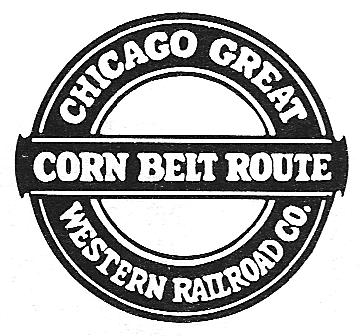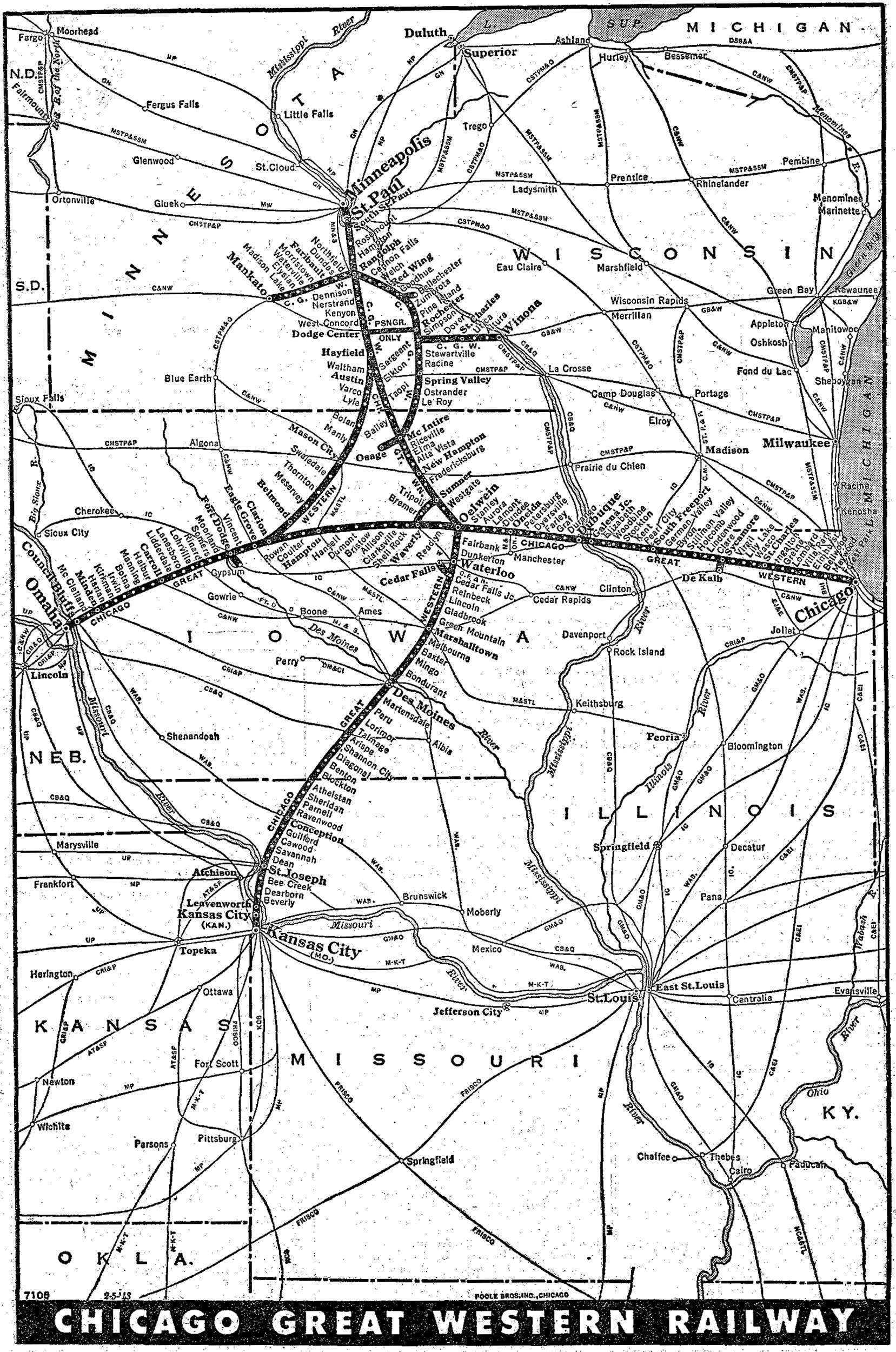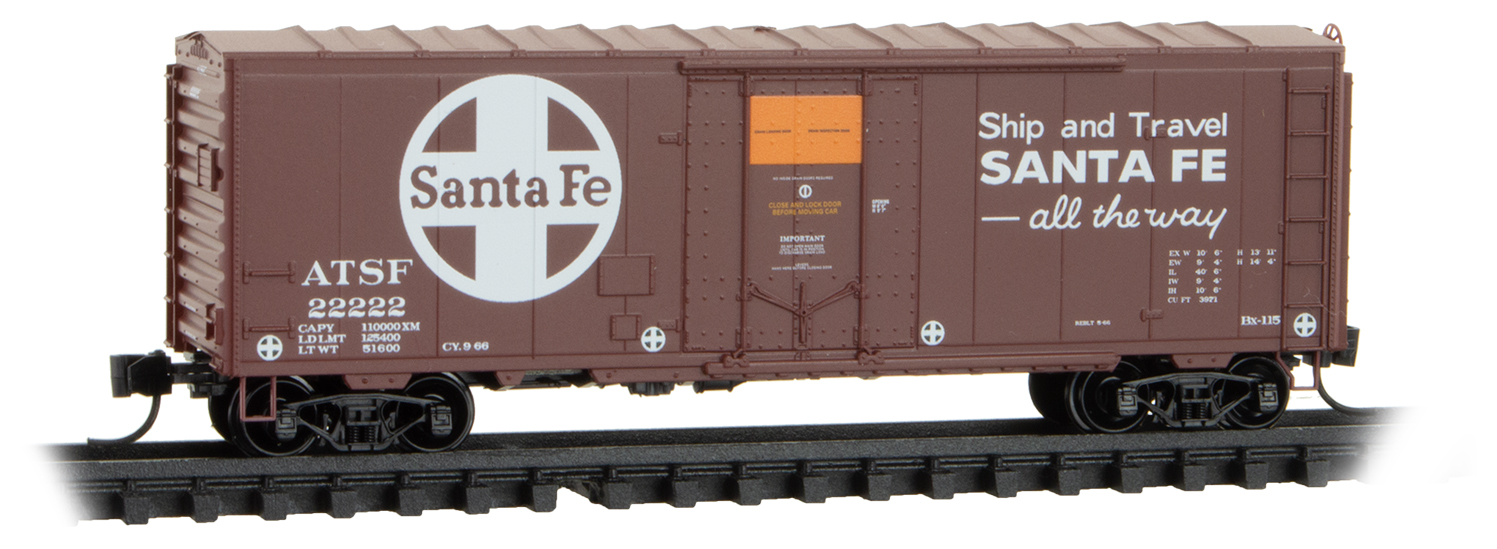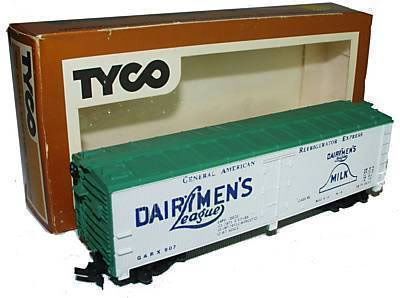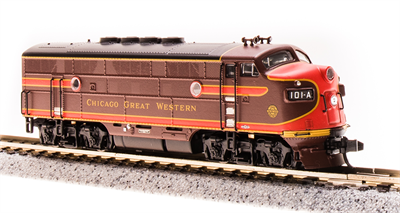Company History: Chicago Great Western was the result of the 1892 reorganization of the Chicago St. Paul & Kansas City. By 1903, the CGW had grown to its maximum size. The CGW had a vaguely cross-shaped system map. The east-west leg started in Chicago and linked Dubuque, Fort Dodge (both in Iowa) and finally Omaha, Nebraska. The north-south line started in St. Paul, Minnesota and linked Waterloo and Des Moines, Iowa then St. Joseph and Kansas City, Missouri. Each axis consisted of a big arc which put CGW at a distance disadvantage to most other railroads servicing the same region – and there were a lot of railroads in the area.
Passenger service was never a major priority and many trains consisted of doodlebugs and trailers even before World War One. In the 1920s CGW did team up with Santa Fe to run through sleepers from the Twin Cities to Los Angeles.
Big mainline power in the 30s and 40s consisted of a fleet of 3 dozen 2-10-4s. In 1936, CGW launched piggyback service – one of the first in the nation. One piggyback customer was a truck line specializing in hauling steel. Since CGW charged by the trailer, the truck line would take the contents of 3 trailers which had maxed out on highway weight and reload all the steel into a single catastrophically heavy trailer that would ride the flat car. They didn’t tell CGW though. No one was the wiser until the landing gear on a trailer punched through the deck of the flat car and derailed a train at speed!
By 1950, CGW had completely dieselized with a mix of Alco, Baldwin and EMD switchers, Alco and EMD road switchers (the former running long hood forward and the latter equipped with dual controls,) and a sizable fleet of EMD F units. By this time, the Deramus family (who already controlled the Kansas City Southern) had gained control of the CGW. Over the years, they cut costs and services. CGW began holding trains until they reached maximum tonnage. Trains between 150 and 250 cars were a daily occurrance behind A-B-B-B-B-A sets of F units. What’s more, these monsters would stop and switch along the way!
Around 1951, they dropped “The Corn Belt Route” logo in favor of the Lucky Strike style logo. The first generation of diesels were delivered in ornate maroon, and red with yellow striping. This was replaced with a simplified solid maroon and then red with black roof (which was essentially the same as neighbor and fellow Deramus controlled Kansas City Southern.) The second generation of diesels consisted entirely of GP30’s and SD40’s.
Despite the iffy service and tremendous competition in the area, and thanks to the cost cutting and a dearth of money losing passenger operations that plagued their neighbors, CGW steadily made money through the 50s and 60s. But, in the age of mergers, it was clear they couldn’t make it on their own. CGW discussed merger with every possible connection but ultimately merged into Chicago & North Western in 1968. In their last full year, the CGW was a 1,411 mile line with 139 locomotives (for comparison, they were about the same size as Western Pacific.)
Passenger service was never a major priority and many trains consisted of doodlebugs and trailers even before World War One. In the 1920s CGW did team up with Santa Fe to run through sleepers from the Twin Cities to Los Angeles.
Big mainline power in the 30s and 40s consisted of a fleet of 3 dozen 2-10-4s. In 1936, CGW launched piggyback service – one of the first in the nation. One piggyback customer was a truck line specializing in hauling steel. Since CGW charged by the trailer, the truck line would take the contents of 3 trailers which had maxed out on highway weight and reload all the steel into a single catastrophically heavy trailer that would ride the flat car. They didn’t tell CGW though. No one was the wiser until the landing gear on a trailer punched through the deck of the flat car and derailed a train at speed!
By 1950, CGW had completely dieselized with a mix of Alco, Baldwin and EMD switchers, Alco and EMD road switchers (the former running long hood forward and the latter equipped with dual controls,) and a sizable fleet of EMD F units. By this time, the Deramus family (who already controlled the Kansas City Southern) had gained control of the CGW. Over the years, they cut costs and services. CGW began holding trains until they reached maximum tonnage. Trains between 150 and 250 cars were a daily occurrance behind A-B-B-B-B-A sets of F units. What’s more, these monsters would stop and switch along the way!
Around 1951, they dropped “The Corn Belt Route” logo in favor of the Lucky Strike style logo. The first generation of diesels were delivered in ornate maroon, and red with yellow striping. This was replaced with a simplified solid maroon and then red with black roof (which was essentially the same as neighbor and fellow Deramus controlled Kansas City Southern.) The second generation of diesels consisted entirely of GP30’s and SD40’s.
Despite the iffy service and tremendous competition in the area, and thanks to the cost cutting and a dearth of money losing passenger operations that plagued their neighbors, CGW steadily made money through the 50s and 60s. But, in the age of mergers, it was clear they couldn’t make it on their own. CGW discussed merger with every possible connection but ultimately merged into Chicago & North Western in 1968. In their last full year, the CGW was a 1,411 mile line with 139 locomotives (for comparison, they were about the same size as Western Pacific.)
Successor/Parent History: The Chicago and North Western Transportation Company (reporting mark CNW) was a Class I railroad in the Midwestern United States. It was also known as the North Western. The railroad operated more than 5,000 miles (8,000 km) of track as of the turn of the 20th century, and over 12,000 miles (19,000 km) of track in seven states before retrenchment in the late 1970s.
Until 1972, when the company was sold to its employees, it was named the Chicago and North Western Railway. The C&NW became one of the longest railroads in the United States as a result of mergers with other railroads, such as the Chicago Great Western Railway, Minneapolis and St. Louis Railway and others.
By 1995, track sales and abandonment had reduced the total mileage back to about 5,000. The majority of the abandoned and sold lines were lightly trafficked branches in Iowa, Illinois, Minnesota, South Dakota and Wisconsin. Large line sales, such as those that resulted in the Dakota, Minnesota and Eastern Railroad further helped reduce the railroad to a mainline core with several regional feeders and branches.
The company was purchased by Union Pacific Railroad (UP) in April 1995 and ceased to exist.
Until 1972, when the company was sold to its employees, it was named the Chicago and North Western Railway. The C&NW became one of the longest railroads in the United States as a result of mergers with other railroads, such as the Chicago Great Western Railway, Minneapolis and St. Louis Railway and others.
By 1995, track sales and abandonment had reduced the total mileage back to about 5,000. The majority of the abandoned and sold lines were lightly trafficked branches in Iowa, Illinois, Minnesota, South Dakota and Wisconsin. Large line sales, such as those that resulted in the Dakota, Minnesota and Eastern Railroad further helped reduce the railroad to a mainline core with several regional feeders and branches.
The company was purchased by Union Pacific Railroad (UP) in April 1995 and ceased to exist.
Brief History: The U.S. is a country of 50 states covering a vast swath of North America, with Alaska in the northwest and Hawaii extending the nation’s presence into the Pacific Ocean. Major Atlantic Coast cities are New York, a global finance and culture center, and capital Washington, DC. Midwestern metropolis Chicago is known for influential architecture and on the west coast, Los Angeles' Hollywood is famed for filmmaking.
Item Links: We found: 2 different collections associated with Chicago Great Western - Railroad
- Collection N Scale Model Trains: 145 different items.
- Collection Z Scale Trains: 11 different items.
Item created by: gdm on 2017-10-10 09:55:58. Last edited by George on 2024-01-08 08:43:20
If you see errors or missing data in this entry, please feel free to log in and edit it. Anyone with a Gmail account can log in instantly.
If you see errors or missing data in this entry, please feel free to log in and edit it. Anyone with a Gmail account can log in instantly.


